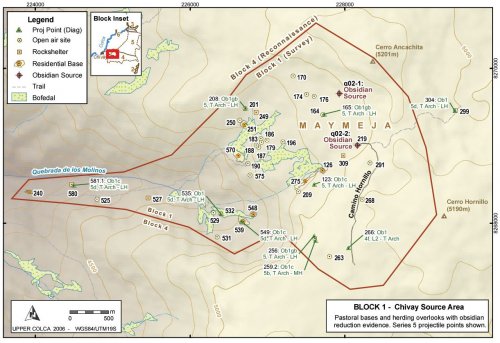Block 1 Early Agropastoralist Settlement pattern
A primary goal of modern pastoralists residing in Maymeja is to guard their flock both during daytime grazing and during the night when rustlers, foxes, and, formerly, mountain lions, are liable to attack the herd (T. Valdivia 2003, pers. comm.). It is evident from regional distributions in the Chivay Source area that during the Terminal Archaic and Formative Period there was a combined interest in herd maintenance with obsidian production. A key feature of the Maymeja area is that procuring obsidian from this zone did not require compromising grazing potential for access to obsidian: both appear to have been available on the southern margins of Maymeja.
Figure 6-49. Block 1 possible Early Agropastoral settlement pattern with Series 5 projectile points.
Residential bases: Several large sites were identified that have been interpreted as residential bases for herders. These residential bases include corrals, possible remnants of residential structures, and site maintenance activity such as the discard of lithics in discrete areas. These bases represent probable overnight camps.
Open air sites: Small sites, consisting typically of a windbreak and a small obsidian scatter overlooking a bofedal, are distributed throughout the Maymeja zone. These small camps, described here as "open air sites" are probable day-use overlooks for herders.
Rock shelters: A number of small rock shelter sites were also encountered in this area. These are typically very small rock shelters, often no more than a small overhang of a boulder or the edge of a lava flow. The shelters commonly contain a small scatter of obsidian flakes, and sometimes cores, at the dripline of the rock shelter.
Miscellaneous other site types: Other kinds of sites include an obsidian quarry pit [q02-2], and Camino Hornillo [a03-268] which is a route leading to the quarry pit from the south.

